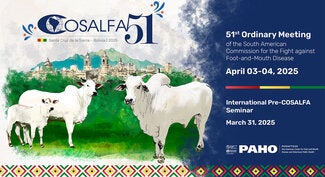The South American Commission for the fight Against Foot-and-Mouth Disease (COSALFA for its initials in Spanish) was established in 1972 at the Fifth Inter-American Ministerial Meeting on Control of Foot-and-Mouth Disease and Other Zoonoses (RICAZ V). At the time, the Pan-American Center for Foot-and-Mouth Disease-PAHO/WHO was entrusted with the function of its Ex Officio Secretariat.
In February 1973 the first COSALFA Meeting was held, which was succeeded by 50 Regular and 6 Special Meetings.
COSALFA was initially formed by 20 representatives from 10 South American countries: Argentina; Brazil; Bolivia; Chili; Colombia; Ecuador; Paraguay; Peru; Venezuela and Uruguay. In 1979, Guyana joined the Commission, in 2012 the Republic of Panama and in 2014 Suriname as a full member.
Since 2015 and COSALFA 42, the Commission is made up of 26 representatives from 13 countries of the American Continent, with a representative of the public sector - that is, of the official veterinary service of each country - and a representative of the private sector - that is, someone connected with the highest national association of livestock producers.
The 13 countries of the American Continent, members of COSALFA are: Argentina; Brazil; Bolivia; Chili; Colombia; Ecuador; Guyana; Panama, Paraguay; Peru; Suriname, Venezuela and Uruguay.
COSALFA’s purpose is to assess the progress made by the national programs for foot-and-mouth disease control and eradication in South America, and recommend actions for these programs, thereby ensuring the regional integration of intervention actions.
At COSALFA meetings observers also participate, including representatives of the official veterinary services, livestock producers’ organizations, the animal products industry, the veterinary pharmaceutical industry, diagnostic laboratories, universities, research institutions, and national and international technical cooperation agencies, among others.


